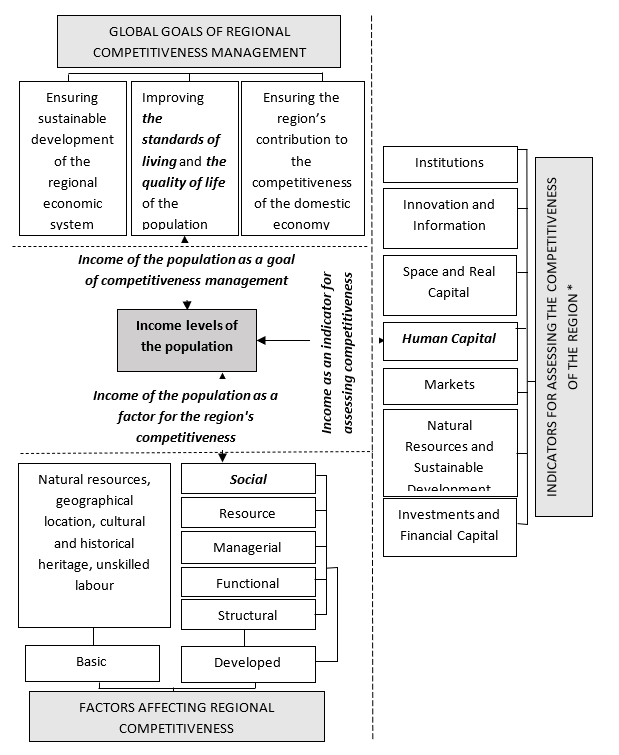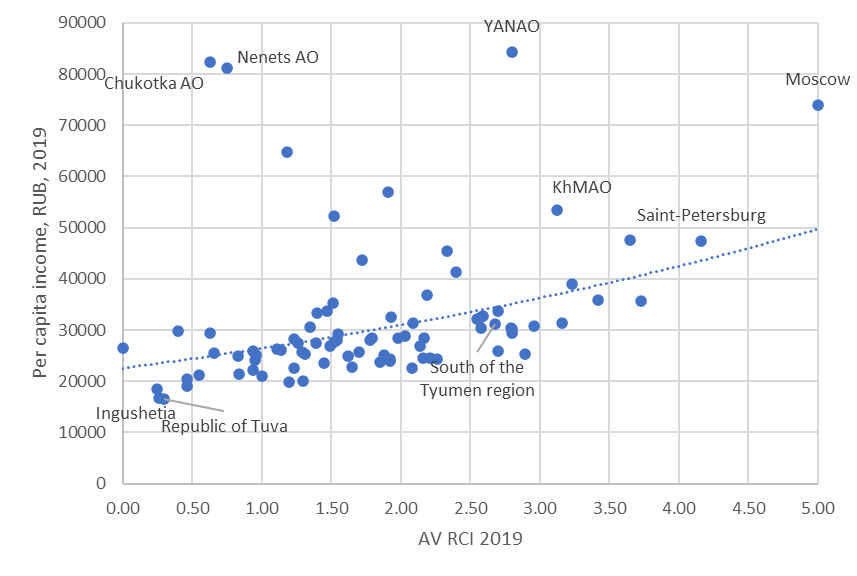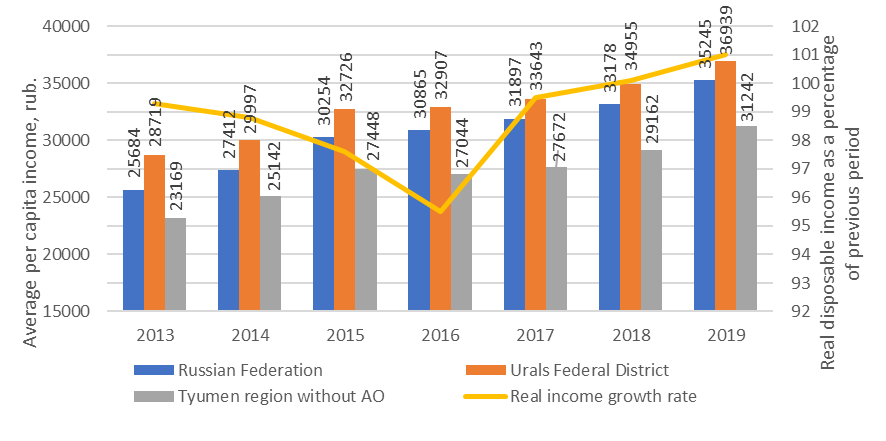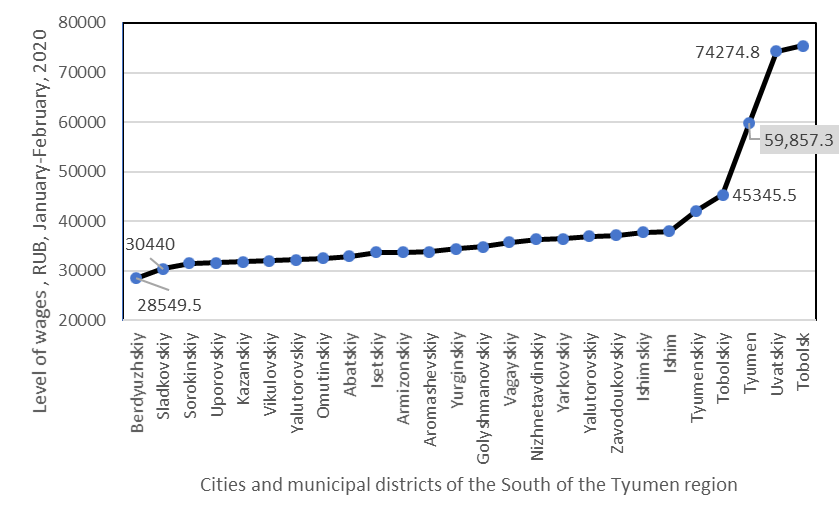Abstract
The concept of a region's competitiveness is inextricably linked to the people's income level. The well-being of residents is considered both a goal or result of the competitiveness of the territory and one of the indicators that can be used to study competitiveness. The article aims to determine the relationship between the income level of the region's population and its competitiveness based on the study of theoretical approaches and empirical data. The authors consider the problems of managing the region's competitiveness through the prism of assessing its inhabitants' income level, taking into account not only the income of the region as a whole but also its territories (cities, rural settlements). Based on the Tyumen region's example, studies are being conducted on objective statistical data of income and subjective assessments of residents of the region and the city of Tyumen of their living standards. As a result, a structural scheme is presented that describes the relationship between the region's competitiveness and income of the population, and the main trends in income changes are identified. The study of a region's competitiveness is a promising tool for developing a strategy and tactics for the socio-economic development of the region, which makes it possible to highlight priority areas of work and conduct a rapid assessment of activities.
Keywords: Competitiveness of the regionincome of the region’s populationself-assessment of the living standard
Introduction
Solving the problems of increasing the country's competitiveness and its regions is of exceptional social and political importance. A more competitive region creates and maintains its competitive advantages, which, in turn, contribute to the sustainable development of the territory, attracting new resources.
Many versatile theoretical and methodological works based on empirical studies of this phenomenon have been published to date. Research focusing on the study of the competitiveness of a territory (region) has been intensifying since the 1990s. In particular, in the European Union, the attention of many scientists is attracted by the issues of competitiveness of regions and individual countries of Europe, because research in this direction makes it possible to assess inequality, management efficiency, the adequacy of development strategies, the sustainability of various territories in comparison with each other. Interesting researches are devoted to the study of the indicators of the regional competitiveness index (EU RCI) (Alexa et al., 2019), its impact on economic growth and income convergence in European regions (Aria et al., 2019), the perception of competitiveness in the context of sustainable development of the European Union (Bristow, 2010); (Nicolas, 2016) and the definition of a new sustainable competitiveness index (Möbius & Althammer, 2020).
In Russian science, interest in the topic of regional competitiveness appeared after 2000 and is now actively growing. Thus, in the largest Russian scientific electronic library (eLIBRARY), there were about 700 publications on regional competitiveness until 2010. The number of studies on this topic has increased almost 4 times over the past 10 years. Most of the works of Russian scientists in this field are related to the assessment and analysis of the region's competitiveness and factors that affect it (Chainikova, 2008); (Gryzunova et al., 2019); (Ivanov et al., 2019); (Shorokhov & Kolkin, 2007). Many Russian studies on regional competitiveness have a clear focus on issues of public administration and the formulation of economic development strategies of territories (Barabanov, 2014); (Grishchenkov et al., 2015); (Tatarkin, 2006).
Regional competitiveness can be understood as the ability of a territory to produce products and provide services that meet national and foreign markets' requirements while maintaining a high and stable level of income of its population.
There are other approaches to defining this concept. Let us summarize the definitions given by various authors (Barabanov, 2014); (Shorokhov & Kolkin, 2007); (Tatarkin, 2006). In their opinion, the competitiveness of the region is:
- its role and place in the country’s economic space, the ability to ensure a high living standard of the population and the ability to realize the economic potential in the region (financial, productive, labour, investment, resource);
- the position of the region and its certain manufactures in the domestic and foreign markets caused by economic, social and other factors, reflected through indicators that adequately characterize its state and its dynamics;
- the ability of the region: 1) to produce goods and services that meet the requirements of domestic and world markets; 2) to create conditions for increasing regional resources (innovative, intellectual, investment) to ensure the growth of the competitiveness potential of businesses, sustainable growth rates of GRP and the quality of life of the region's population reaching world-class level.
From the above, it becomes obvious that the definition of a region's competitiveness covers at least 3 main components: population's standard of living, sustainable economic development, and the production of competitive goods.
Regional competitiveness is determined by many factors that interact with each other, and the combination of which can create a strong and stable competitive position. Competitiveness factors are defined as certain characteristics of the region, driving forces, reasons, and motives that contribute to identifying and using internal resources and external opportunities for its development. Combining factors that ensure the region's competitiveness in relation to other territories can be considered its competitive advantages. Saveliev (2010) divides factors of competitiveness into natural and artificial, and offers the corresponding primary and secondary competitive advantages of the region. He believes that the following competitive advantages correspond to natural factors of competitiveness: natural resources, favorable economic and geographical location of the region, the number, structure and quality of labour resources, national and cultural characteristics of the local population, etc. And artificial factors of competitiveness form secondary competitive advantages: scientific and innovative potential, image of the region, level of infrastructure development, investment attractiveness, attractiveness for life, etc. In Russian studies, there is a division of regional competitiveness factors into internal and external (Chainikova, 2008), exogenous and endogenous (Shastitko, 2009), objective and subjective, historically established and newly created. In most of these approaches, the first group of regional competitiveness factors is considered a "given", historical and geographically determined, and the second group is the factors that can be formed by the region, making certain efforts for this. The population's standard of living and the level of income are included in the second group of factors and build the competitive advantages of a high level.
An objective assessment of the region's competitiveness is the starting point for developing measures to improve competitiveness. This is because the authorities have to understand what potential the territory has, what place it occupies among other regions, how existing competitive advantages are used, and what factors can be influenced, what is the basis for developing new competitive advantages, which territories are the strongest competitors, and which regions can be considered as strategic partners.
There are different methods for assessing the competitiveness of regions. Traditionally, the region’s competitiveness was determined by calculating the indices. Among the most famous:
- Global Competitiveness Index (GCI), calculated by the World Economic Forum (WEF) since 2004 (Schwab, 2019);
- Business Competitiveness Index (BCI), based on Porter's theory of competitive advantages and assessing the competitiveness of territories at the micro level (Porter, 2004);
- the European Commission's Regional Competitiveness Index (RCI) - the analysis of the RCI, its three sub-indexes, and 11 dimensions help highlight each region's strengths and weaknesses with the possibility to benchmark each one to the EU average or its peers (Annoni & Dijkstra, 2019).
Russian scientists have also proposed methods for assessing regions' competitiveness, differing mainly by the composition of indicators. Most of the methods use a multifactorial approach, where the integral level of the region's competitiveness is determined based on an assessment of a fairly large number of indicators. At the same time, there are other approaches. Thus, Pechatkin, Salikhov, Sablina proposed a two-factor model for assessing a region's competitiveness based on relative assessments of product competitiveness and population's quality of life. (Pechatkin et al., 2004). In the Russian Federation, the AV RCI method for assessing the region’s competitiveness is actively used. The AV Group Center annually calculates competitiveness indices for all regions of Russia in 7 key areas or factors of competition (AV Competitiveness), which are close to the well-known world indices: Markets (products and economic complexes); Institutions (state, private and public); Human Capital; Innovation and Information; Natural Resources and Sustainable Development; Space and Real capital; Investment and Financial Capital (AV Group, 2019).
According to the research of the authors of the article, the indicator "Income of the population" is included in almost all existing methodologies for calculating the competitiveness index, mainly as a private indicator in a larger block of indicators, and this is not accidental. In the conditions of the "knowledge economy" regions are increasingly competing with each other not only for investments or consumers, but also for attracting qualified, initiative specialists capable of non-standard innovative ideas. At the same time, the standard of living in the region is becoming the main tool for attracting valuable human resources. High standards and quality of life of the region's population are regarded as the main means of achieving the competitiveness of the regional economy, and the level of income serves as an indicator for its assessment.
Problem Statement
It is advisable to consider the goal of income growth in the region and sustainable development of the region through the prism of the mutual influence of the level of income and the region’s competitiveness. Both goals - increasing competitiveness and raising the income levels of the population - are priorities for the regional authorities. Especially in the context of the declining level of real income of the Russian population since 2014. Consequently, the issues of measuring and assessing the competitiveness of the region, as well as the factors that determine it, are relevant for the constituent entities of the Russian Federation, which bear a certain responsibility to the public for the formation and maintenance of conditions for sustainable growth (or no fall) of income/
Research Questions
The research questions were: how can the mutual influence of the income levels of the population and the region’s competitiveness be described; is there a relationship between these indicators; how the incomes of the population in the South of the Tyumen region changed in recent years; what are the differences in the income levels of the population of this region as a whole and its individual territories (cities, rural settlements); how do residents of the South of the Tyumen region subjectively assess their income; what conclusions and recommendations for regional authorities can be made on the basis of the study.
Purpose of the Study
Objective of the study is to determine the relationship between the income level of the region’s population and its competitiveness on the basis of the study of theoretical approaches and empirical data.
Research Methods
The following methods were used to achieve the research goal: analysis of theoretical works on the problem of regional competitiveness, comparison and systematization of empirical and theoretical data. The empirical base of the work was made up of statistical data on the income levels of the population of the Russian Federation, the Ural Federal district and the Tyumen region (excluding autonomous districts) from 2013 to 2019, the results of calculations of the AV RCI competitiveness index for the regions of the Russian Federation for 2018 and 2019. We used the results of the study of the social well-being of the Tyumen region’s population in 2006-2019 (Andrianova et al., 2019).
Findings
The research carried out by the authors made it possible to construct a structural scheme of the relationship between the income levels of the population and the competitiveness of the region (Figure
The income levels of the population act as a goal of managing the region’s competitiveness, as a factor or driving force influencing competitiveness, and at the same time as an indicator for assessing regional competitiveness:
1. Incomes of the population as the goal of competitiveness management. Indeed, at the beginning of the article, we talked about the fact that the region’s competitiveness is determined inter alia by its ability to maintain high and stable income levels of its population. Moreover, according to Meyer-Stamer (2008), “we can define (systemic) competitiveness of a territory as the ability of a locality or region to generate high and rising incomes and improve the livelihoods of the people living there” (p. 8). In other word, increasing the population's income is a global goal of managing regional competitiveness.
2. Income of the population as a factor of regional competitiveness. It is based on the approach of the authors, who believe that it is possible to distinguish two groups of factors that affect the region’s competitiveness – basic (historically formed) which are natural resources of the territory demanded by the market, geographical location, etc. and developed (newly created). This approach is similar to the approaches to identifying factors analyzed earlier in the article. The developed ones include structural, functional, managerial, resource and social factors, which in turn include the standards of living and income of the population. Social factors are to provide conditions for living and economic activity of the population on the territory of the region. These factors are important in the development of territorial competitiveness, as they attract highly qualified labour, and contribute to the emergence of new growth zones. If the income levels are sufficient to motivate and develop human potential, it can provide a positive increase in GRP which is a key parameter for assessing the region's competitiveness.

We should not forget that the income and standards of living of the population determine the purchasing power and the level of consumption. In other words, the income of the population forms the demand in the consumer market, which ultimately affects the revenue of regional companies.
3. Income of the population as an indicator for assessing competitiveness. From the variety of existing approaches to assessing competitiveness for the scheme in Figure
Continuing our research, we will try to find out whether there is a relationship between the population's income and the level of competitiveness of the region. To do this, we will build a scatter diagram by variables: "average per capita income" (by regions of the Russian Federation, for 2019) and the Regional Competitiveness Index AV RCI 2019 (Figure

The relationship between the income of the population and the AV RCI index by regions of Russia is seen in the Figure
The region we study – the Tyumen region (without the Khanty-Mansiysk and Yamalo-Nenets Autonomous districts) – is consistently in the top 20 of the AV RCI index (with a total number of regions – 85). AV RCI of the South of the Tyumen region for 2015-2019 decreased slightly from 2.76 to 2.68. The "Human capital" index, which includes the private indicator "per Capita income of the population", has also decreased over the years from 2.55 to 2.34.
Let us consider the dynamics of the average per capita income of the population in the region (Figure

Figure
The income of the population of the South of the Tyumen region, according to Figure
The uneven socio-economic development is due to most industrial enterprises' concentration in 7 out of 26 territories of the South of the region. Thus, in the production structure, the city districts of Tyumen and Tobolsk, the Tyumen and Uvatsky municipal districts are leaders. This leads to territorial differentiation of the socio-economic situation by industries and municipalities in the South of the region.

It was encouraging that the residents of the South of the Tyumen region assess their financial situation rather positively. Thus, the subjective public’s perception of their level of well-being is increasing - in 2019, 51% of the population considered themselves to be "prosperous" and "rich" compared to 2016, when the figure was 41%. A distinctive feature of the region is that, over the years of observation, the layer of “prosperous” and “rich” in the region on average turned out to be two times wider than in Russia as a whole (Table
Thus, the study of the situation with the income level in the south of the Tyumen region showed a high self-esteem of the living standards in the region, but also revealed problems that may hinder the further growth of the region's competitiveness. These problems are associated with the high differentiation of incomes of the population in the South of the Tyumen region, the incomes lags behind the all-Russian level.
Conclusion
As a result, the following conclusions can be drawn from the study:
The population's income level acts as the goal of managing the region's competitiveness as a factor affecting competitiveness, and at the same time as an indicator for assessing regional competitiveness.
The average per capita income of the population and the competitiveness of the region are correlated. There is a mutual influence of these indicators within the territory – a more competitive region attracts investment, highly qualified personnel, develops production, and increases the population's income GRP. In turn, residents with a higher income level generate demand for goods and stimulate the service sector, which attracts additional resources to the region. At the same time, competitiveness is more dynamic than the income levels of the population and depends on many factors.
The Tyumen region (without autonomous districts) is consistently in the top 20 in terms of AV RCI competitiveness, but statistics show that the region lags behind Russia's average value in terms of "income of the population". Since the relationship between the income levels of the population and regional competitiveness is strong and inextricable, it is advisable to define an improvement of the living standards of the Tyumen region's population as one of the priorities for the regional competitiveness management.
Acknowledgments
The study was funded by the Russian Foundation for Basic Research (RFBR), project number 19-010-00801.
References
- Alexa, D., Cismas, L., Rus, A., & Silaghi, M. (2019). Economic Growth, Competitiveness and Convergence in the EU Regions. A Spatial Model Estimation. Journal of Economic Computation and Economic Cybernetics Studies and Research, 53(1), 107–124.
- Andrianova, E. V., Davydenko, V. A., Danilova, E. P., Maltseva, N. V., Pecherkina, I. F., Romashkina, G. F., Tarasova, A. N., Ushakova, Yu. V., Khudyakova, M. V., Cheblakov, A. L., Davydenko, V. A., Romashkina, G. F., Didenko, N. I., & Kogai, E. A. (2019). Novaya industrializatsiya: vozmozhnosti, ogranicheniya i protivorechiya sotsiokul'turnogo prostranstva [New industrialization: opportunities, restrictions and contradictions of sociocultural space]. Tyumen: Tyumen Regional Duma.
- Annoni, P., & Dijkstra, L. (2019). The EU Regional Competitiveness Index 2019. Luxembourg: Publications Office of the European Union. https://ec.europa.eu/regional_policy/sources/docgener/work/2019_03_rci2019.pdf
- Aria, M., Gaeta, G. L., & Marani, U. (2019). Similarities and Differences in Competitiveness Among European NUTS2 Regions: An Empirical Analysis Based on 2010–2013 Data. Social Indicators Research, 142(1), 431–450.
- AV Group. (2019). Indeks konkurentosposobnosti regionov Rossii 2019 [Index of Competitiveness of Russian Regions]. http://lc-av.ru/wp-content/uploads/2019/11/AV_RCI_2019_beta.pdf
- Barabanov, A. S. (2014). Upravleniye regional'noy konkurentosposobnost'yu [Regional Competitiveness Management]. Vologda: ISEDT RAS. Institute of Socio-Economic Development of Territories.
- Bristow, G. (2010). Resilient regions: replacing regional competitiveness. Cambridge Journal of Regions, Economy and Society, 3(1), 153–167.
- Chainikova, L. N. (2008). Metodologicheskiye i prakticheskiye aspekty otsenki konkurentosposobnosti regiona [Methodological and Practical Aspects of Assessing the Competitiveness of the Region]. Tambov, Publishing house of TSTU.
- Grishchenkov, A. I., Fedotenkov, D. G., & Padalko, A. A. (2015). Problemy upravleniya mezhregional'noy konkurentsiyey [Problems of management of interregional competition]. Bulletin of Bryansk State University, 3, 273-277.
- Gryzunova, N. V., Pyatanova, V. I., Ordov, K. V., & Manuylenko, V. V. (2019). Models of Credit Limit-Setting for Companies as a Means of Encouraging Competitiveness. Entrepreneurship and sustainability issues, 7(1), 615-625.
- Ivanov, V. V., Lvova, N. A., & Pokrovskaia, N. V. (2019). Financial Incentives of Economic Growth in Emerging Markets: Evidence from Russia. New Challenges of Economic and Business Development – 2019: Incentives for Sustainable Economic Growth. Proceedings, 229-309.
- Meyer-Stamer, J. (2008). Systematic competitiveness and local economic development. Discussion Paper. Duisberg, Germany: Mesopartner.
- Möbius, Р., & Althammer, W. (2020). Sustainable competitiveness: a spatial econometric analysis of European regions. Journal of Environmental Planning and Management, Taylor & Francis Journals, 63(3), 453-480.
- Nicolas, C. G. (2016). Territorial competitiveness and The European Investment Plan against Regional Inequality. Investigaciones Regionales-Journal of Regional Research, 35, 177-201.
- Pechatkin, V. V., Salikhov, S. U., & Sablina, V. A. (2004). Reytingovaya otsenka konkurentosposobnosti regionov Rossii [Rating assessment of the competitiveness of Russian regions]. Ufa: Institute of Social and Economic Research of the Ufa Scientific Center of the Russian Academy of Sciences.
- Porter, М. (2004). Building the Microeconomic Foundations of Prosperity: Findings from the Business Competitiveness Index. In M. E. Porter, K. Schwab, X. Sala-i-Martin (Eds.), The Global Competitiveness Report 2003-2004 (pp. 29-56). Oxford: Oxford University Press. https://www.hbs.edu/faculty/Publication%20Files/BCI_Chapter_adf284c6-3d8b-483e-9f29-a5242e9c5999.pdf
- Saveliev, Y. V. (2010). Upravleniye konkurentosposobnost'yu regiona: ot teorii k praktike [Regional competitiveness management: from theory to practice]. Petrozavodsk: Karelian Scientific Center of the Russian Academy of Sciences.
- Schwab, K. (2019). The Global Competitiveness Report 2019. Cologny/Geneva: World Economic Forum. http://www3.weforum.org/docs/WEF_TheGlobalCompetitivenessReport2019.pdf
- Shastitko, A. Ye. (2009). Konkurentosposobnost' regiona: soderzhaniye, faktory, politika [Competitiveness of the region: content, factors, policy]. Baltic region, 1(1), 11 - 31. https://doi.org/10.5922 / 2074-9848-2009-1-2
- Shorokhov, V. P., & Kolkin, D. N. (2007). Otsenka konkurentosposobnosti regiona [Assessment of the competitiveness of the region]. Problems of forecasting, 18(1), 92-101.
- Tatarkin, A. I. (2006). Formirovaniye konkurentnykh preimushchestv regionov [Formation of competitive advantages of regions]. Region: economics and sociology, 1, 141-154. http://ecsocman.hse.ru/data/061/771/1223/Tatarkin.pdf
- Voronova, N. S., & Miroshnichenko, O. S. (2018). People’s incomes as a potential for development of bank lending: comparative analysis of Russian regions. Economic and Social Changes: Facts, Trends, Forecast, 11(4), 144-159. https://doi.org/10.15838/esc.2018.4.58.9
Copyright information

This work is licensed under a Creative Commons Attribution-NonCommercial-NoDerivatives 4.0 International License.
About this article
Publication Date
16 April 2021
Article Doi
eBook ISBN
978-1-80296-104-1
Publisher
European Publisher
Volume
105
Print ISBN (optional)
-
Edition Number
1st Edition
Pages
1-1250
Subjects
Sustainable Development, Socio-Economic Systems, Competitiveness, Economy of Region, Human Development
Cite this article as:
Shumilova, Y., Danilova, E., & Miroshnichenko, O. (2021). Income Of The Population As A Factor Of Region's Competitiveness. In E. Popov, V. Barkhatov, V. D. Pham, & D. Pletnev (Eds.), Competitiveness and the Development of Socio-Economic Systems, vol 105. European Proceedings of Social and Behavioural Sciences (pp. 927-938). European Publisher. https://doi.org/10.15405/epsbs.2021.04.98

